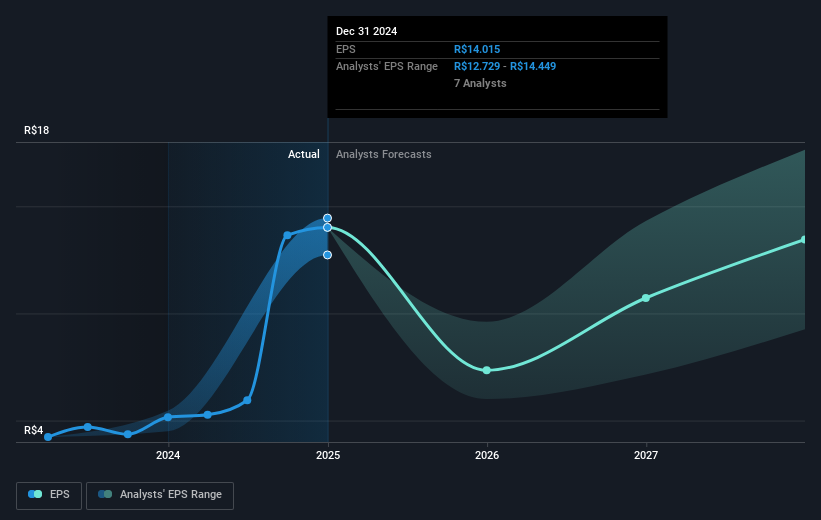Companhia de Saneamento Básico do Estado de São Paulo - SABESP's (BVMF:SBSP3) investors will be pleased with their impressive 222% return over the last five years
The worst result, after buying shares in a company (assuming no leverage), would be if you lose all the money you put in. But when you pick a company that is really flourishing, you can make more than 100%. For instance, the price of Companhia de Saneamento Básico do Estado de São Paulo - SABESP (BVMF:SBSP3) stock is up an impressive 189% over the last five years. Also pleasing for shareholders was the 17% gain in the last three months. This could be related to the recent financial results, released recently - you can catch up on the most recent data by reading our company report.
With that in mind, it's worth seeing if the company's underlying fundamentals have been the driver of long term performance, or if there are some discrepancies.
Our free stock report includes 2 warning signs investors should be aware of before investing in Companhia de Saneamento Básico do Estado de São Paulo - SABESP. Read for free now.While the efficient markets hypothesis continues to be taught by some, it has been proven that markets are over-reactive dynamic systems, and investors are not always rational. By comparing earnings per share (EPS) and share price changes over time, we can get a feel for how investor attitudes to a company have morphed over time.
Over half a decade, Companhia de Saneamento Básico do Estado de São Paulo - SABESP managed to grow its earnings per share at 23% a year. That makes the EPS growth particularly close to the yearly share price growth of 24%. Therefore one could conclude that sentiment towards the shares hasn't morphed very much. In fact, the share price seems to largely reflect the EPS growth.
The image below shows how EPS has tracked over time (if you click on the image you can see greater detail).

We know that Companhia de Saneamento Básico do Estado de São Paulo - SABESP has improved its bottom line over the last three years, but what does the future have in store? This free interactive report on Companhia de Saneamento Básico do Estado de São Paulo - SABESP's balance sheet strength is a great place to start, if you want to investigate the stock further.
What About Dividends?
When looking at investment returns, it is important to consider the difference between total shareholder return (TSR) and share price return. The TSR incorporates the value of any spin-offs or discounted capital raisings, along with any dividends, based on the assumption that the dividends are reinvested. So for companies that pay a generous dividend, the TSR is often a lot higher than the share price return. In the case of Companhia de Saneamento Básico do Estado de São Paulo - SABESP, it has a TSR of 222% for the last 5 years. That exceeds its share price return that we previously mentioned. This is largely a result of its dividend payments!
A Different Perspective
We're pleased to report that Companhia de Saneamento Básico do Estado de São Paulo - SABESP shareholders have received a total shareholder return of 31% over one year. That's including the dividend. Since the one-year TSR is better than the five-year TSR (the latter coming in at 26% per year), it would seem that the stock's performance has improved in recent times. In the best case scenario, this may hint at some real business momentum, implying that now could be a great time to delve deeper. I find it very interesting to look at share price over the long term as a proxy for business performance. But to truly gain insight, we need to consider other information, too. Take risks, for example - Companhia de Saneamento Básico do Estado de São Paulo - SABESP has 2 warning signs (and 1 which can't be ignored) we think you should know about.
If you are like me, then you will not want to miss this free list of undervalued small caps that insiders are buying.
Please note, the market returns quoted in this article reflect the market weighted average returns of stocks that currently trade on Brazilian exchanges.
Have feedback on this article? Concerned about the content? Get in touch with us directly. Alternatively, email editorial-team (at) simplywallst.com.
This article by Simply Wall St is general in nature. We provide commentary based on historical data and analyst forecasts only using an unbiased methodology and our articles are not intended to be financial advice. It does not constitute a recommendation to buy or sell any stock, and does not take account of your objectives, or your financial situation. We aim to bring you long-term focused analysis driven by fundamental data. Note that our analysis may not factor in the latest price-sensitive company announcements or qualitative material. Simply Wall St has no position in any stocks mentioned.
 Index Options
Index Options CME Group
CME Group Nasdaq
Nasdaq Cboe
Cboe TradingView
TradingView Wall Street Journal
Wall Street Journal